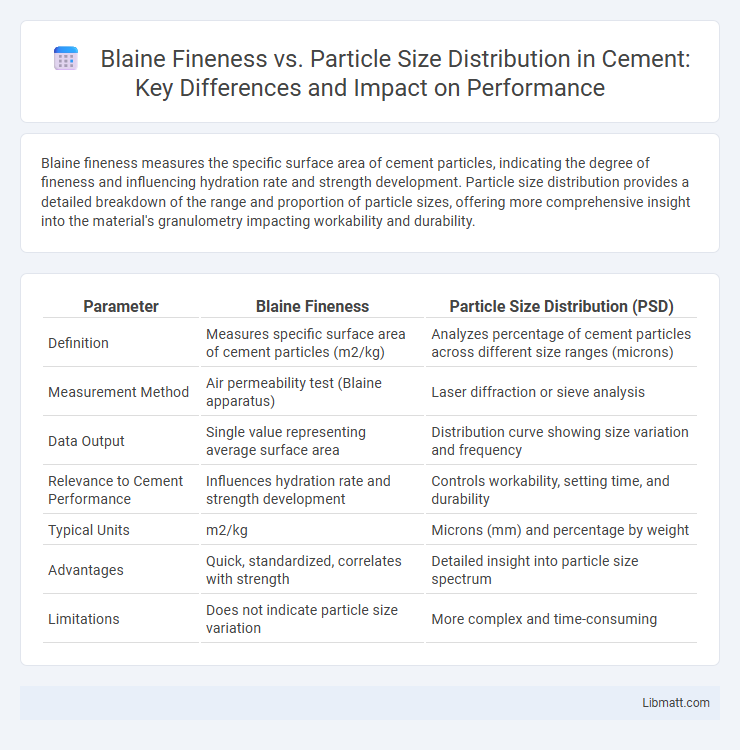Blaine fineness measures the specific surface area of cement particles, indicating the degree of fineness and influencing hydration rate and strength development. Particle size distribution provides a detailed breakdown of the range and proportion of particle sizes, offering more comprehensive insight into the material's granulometry impacting workability and durability.
Table of Comparison
| Parameter | Blaine Fineness | Particle Size Distribution (PSD) |
|---|---|---|
| Definition | Measures specific surface area of cement particles (m2/kg) | Analyzes percentage of cement particles across different size ranges (microns) |
| Measurement Method | Air permeability test (Blaine apparatus) | Laser diffraction or sieve analysis |
| Data Output | Single value representing average surface area | Distribution curve showing size variation and frequency |
| Relevance to Cement Performance | Influences hydration rate and strength development | Controls workability, setting time, and durability |
| Typical Units | m2/kg | Microns (mm) and percentage by weight |
| Advantages | Quick, standardized, correlates with strength | Detailed insight into particle size spectrum |
| Limitations | Does not indicate particle size variation | More complex and time-consuming |
Introduction to Blaine Fineness and Particle Size Distribution
Blaine Fineness measures the specific surface area of powdered cement particles, expressed in cm2/g, indicating how finely ground the material is. Particle Size Distribution (PSD) quantifies the proportion of particles across various size ranges, typically analyzed using laser diffraction or sieving methods. Both Blaine Fineness and PSD critically influence cement hydration, strength development, and workability in concrete applications.
Key Differences Between Blaine Fineness and Particle Size Distribution
Blaine fineness measures the specific surface area of cement particles, reflecting their ability to react with water and influence setting time, while particle size distribution (PSD) quantifies the range and proportion of particle sizes in a sample, impacting properties like workability and strength development. Unlike PSD, which provides a detailed profile of particle sizes, Blaine fineness offers a single value representing surface area per unit weight, essential for assessing cement reactivity. Understanding these key differences helps you optimize material performance by selecting the appropriate characterization method for your cementitious materials.
Importance of Measuring Blaine Fineness
Measuring Blaine Fineness is crucial for determining the specific surface area of cement particles, directly affecting hydration rates and strength development in concrete. Accurate Blaine Fineness values ensure optimal particle size distribution, leading to consistent workability and durability in your construction projects. Precise control of this parameter enhances cement quality and performance predictability.
Understanding Particle Size Distribution in Materials
Blaine fineness measures the specific surface area of powdered materials, providing critical insight into their reactivity and performance in applications such as cement and mineral processing. Particle size distribution (PSD) complements this by detailing the proportion of particles across different size ranges, influencing properties like flowability, packing density, and strength development. Understanding the interplay between Blaine fineness and PSD enables precise control of material characteristics, optimizing processing efficiency and end-product quality.
How Blaine Fineness Influences Material Properties
Blaine fineness, expressed as specific surface area in m2/kg, directly impacts the reactivity and hydration rate of cementitious materials by affecting the surface area available for chemical reactions. Finer particles accelerate early strength development and improve workability but may increase water demand and heat evolution during curing. Optimizing particle size distribution and Blaine fineness balances strength gain, durability, and processing characteristics in cement and concrete formulations.
Techniques for Measuring Particle Size Distribution
Techniques for measuring particle size distribution include laser diffraction, dynamic light scattering, and sieve analysis, each offering distinct advantages for assessing granular materials. Blaine fineness specifically measures the specific surface area of powders, typically cement, through air permeability methods, providing insight into particle fineness that complements size distribution data. Understanding both Blaine fineness and particle size distribution techniques helps optimize your material processing and performance in construction applications.
Relationship Between Blaine Fineness and Particle Size Distribution
Blaine fineness measures the specific surface area of cement particles, directly reflecting the particle size distribution by indicating the average particle size and texture. A higher Blaine fineness value corresponds to finer particles, which enhance cement hydration and strength development. Understanding your material's particle size distribution through Blaine fineness helps optimize cement performance in construction applications.
Applications in Cement and Construction Industries
Blaine fineness directly influences the particle size distribution of cement, playing a critical role in determining its hydration rate and strength development. Finer particles measured by Blaine fineness increase surface area, enhancing the cement's reactivity and improving early strength gain in construction applications. Your selection of cement with optimized particle size distribution ensures better workability, durability, and long-term performance in concrete structures.
Challenges in Measurement and Interpretation
Blaine fineness, a standard metric for cement particle size, faces challenges in accurately capturing the full particle size distribution (PSD) due to its reliance on air permeability rather than direct size measurement. Variability in pore structure and particle shape often leads to discrepancies between Blaine fineness values and actual PSD, complicating the interpretation of cement reactivity and performance. Advanced techniques like laser diffraction or sedimentation analysis provide complementary PSD data, but integrating these with Blaine measurements remains complex for consistent quality control.
Future Trends in Particle Characterization Methods
Advancements in particle characterization are shifting from traditional Blaine fineness measurements to more comprehensive particle size distribution (PSD) analyses using laser diffraction and dynamic light scattering techniques. Future trends emphasize integrating real-time, in-line monitoring systems with machine learning algorithms to optimize cement grinding efficiency and concrete performance. Enhanced PSD methods provide detailed granulometric insights, enabling improved mix design and quality control across construction materials.
Blaine Fineness vs Particle Size Distribution Infographic

 libmatt.com
libmatt.com